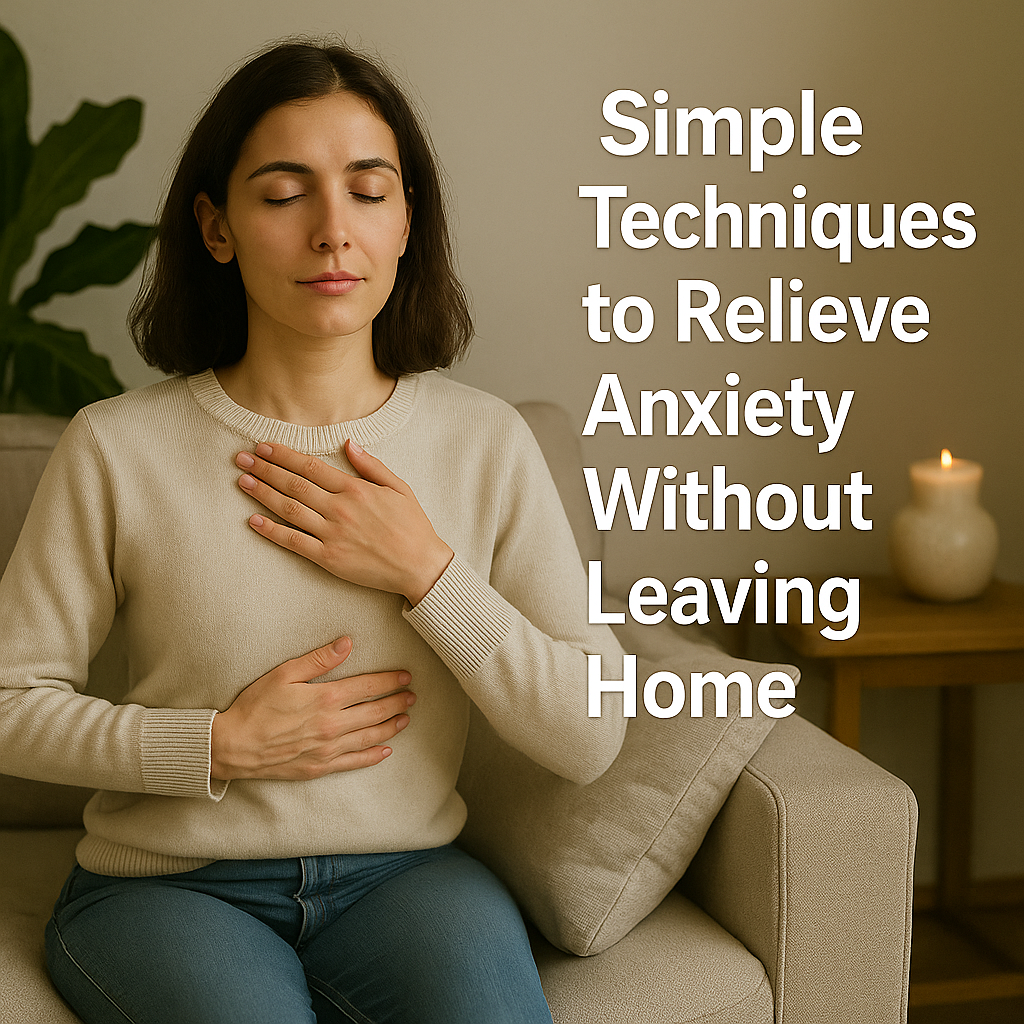Anxiety is a natural part of life, but when it becomes overwhelming or constant, it can interfere with your ability to live peacefully. While professional help is sometimes necessary, there are many simple, effective ways to reduce anxiety right from the comfort of your home.
Whether you’re dealing with occasional stress or chronic anxiety, this article will guide you through practical, no-cost techniques that can help bring you back to a calmer state of mind.
Understanding Anxiety: A Quick Overview
Anxiety is your body’s natural response to stress or perceived danger. It’s part of the “fight or flight” response and can manifest as:
- Racing thoughts
- Tight chest or shallow breathing
- Restlessness
- Difficulty concentrating
- Irritability
The key to managing anxiety is not to eliminate it completely, but to change how you respond to it.
1. Try the 4-7-8 Breathing Technique
This simple breathing method slows down your nervous system and promotes calm almost instantly.
How to do it:
- Inhale through your nose for 4 seconds
- Hold your breath for 7 seconds
- Exhale through your mouth slowly for 8 seconds
- Repeat for 4–6 cycles
Doing this several times a day, especially during moments of tension, can significantly reduce your anxiety levels.
2. Ground Yourself with the 5-4-3-2-1 Technique
This is a great tool when anxiety makes you feel disconnected from the present moment.
Here’s how it works:
- 5 things you can see
- 4 things you can touch
- 3 things you can hear
- 2 things you can smell
- 1 thing you can taste
This technique brings your attention back to your senses, interrupting anxious thought loops.
3. Create a “Calm Space” at Home
You don’t need a full meditation room—just a quiet, clutter-free corner with soft lighting, a plant, or anything comforting.
In this space, you can:
- Meditate
- Journal
- Practice breathing exercises
- Read calming quotes or affirmations
The idea is to associate this space with peace and emotional reset.
4. Limit Stimulants and Add Soothing Foods
What you consume impacts your mental state. Caffeine, sugar, and processed foods can heighten anxiety symptoms.
Tips:
- Replace coffee with calming herbal teas (like chamomile or peppermint)
- Avoid energy drinks and excess sugar
- Include more magnesium-rich foods like spinach, almonds, and bananas
A simple swap in your morning beverage can make a surprising difference in your mood.
5. Move Your Body – Gently
You don’t need an intense workout to reduce anxiety. Light movement boosts endorphins, improves circulation, and grounds your mind.
Options include:
- A short walk around your house or yard
- Gentle yoga or stretching routines
- Dancing to your favorite music
- Doing a few jumping jacks or squats
The goal is to move in a way that feels kind to your body.
6. Practice a Daily “Worry Dump” Journal
Anxiety loves mental clutter. Journaling helps you unload it.
Try this:
- Every night, write down everything that’s bothering you
- Don’t censor yourself—just let the thoughts flow
- Then, write a calming sentence: “I’ve acknowledged my thoughts, now I choose peace.”
This clears your mental space before bed and helps you rest more peacefully.
7. Listen to Nature or Binaural Sounds
Soothing sounds can shift your brainwaves and induce a relaxed state.
Recommended:
- Rainfall or ocean waves
- Forest ambiance
- White noise or brown noise
- Binaural beats for anxiety relief
You can find these on YouTube, Spotify, or specific wellness apps. Try listening while working, studying, or winding down.
8. Use Affirmations That Calm the Mind
Words shape your reality. Saying calming affirmations throughout the day can help reprogram anxious thoughts.
Examples:
- “I am safe in this moment.”
- “This feeling is temporary.”
- “I trust myself to handle whatever comes.”
- “I am grounded, calm, and in control.”
Write them on sticky notes, repeat them aloud, or add them to your phone lock screen.
9. Digital Detox Time
Screens can intensify anxiety, especially news and social media. Consider setting tech boundaries:
- Turn off non-essential notifications
- Avoid your phone the first and last hour of the day
- Have at least one “offline” hour daily
Instead, replace screen time with mindful or creative activities.
10. Aromatherapy and Scents
Smell is a direct link to the emotional center of the brain. Certain scents can calm the nervous system almost instantly.
Options:
- Lavender oil (calming and sleep-inducing)
- Bergamot (uplifting and soothing)
- Frankincense (grounding)
- Peppermint (refreshing and tension-relieving)
Use a diffuser, apply a diluted drop to your wrists, or simply inhale from the bottle.
How to Know These Techniques Are Helping
After practicing for a few days or weeks, you might start to notice:
- Shorter duration of anxious thoughts
- Easier time falling or staying asleep
- More ability to stay focused during the day
- Reduced physical symptoms like racing heart or shallow breathing
- Feeling more in control and less overwhelmed
You don’t need to try everything at once. Pick 2 or 3 techniques that resonate most with you and stick to them for a week.
Your Calm is Closer Than You Think
Anxiety doesn’t mean you’re broken—it means your nervous system is overwhelmed and asking for support. These techniques offer small but powerful ways to reconnect with peace and steadiness.
Remember, you’re not alone, and you don’t need a perfect environment to find relief. Often, just 5 minutes of intentional calm can shift your entire day.
Start small. Stay consistent. And remind yourself—you have more power over your peace than you think.

